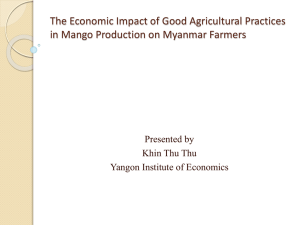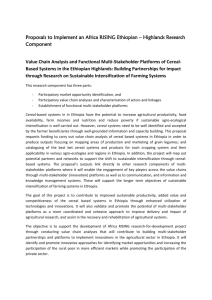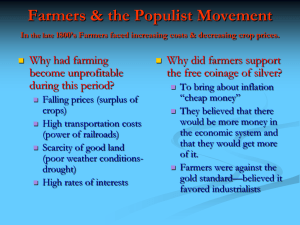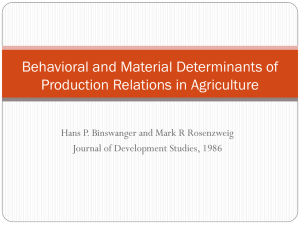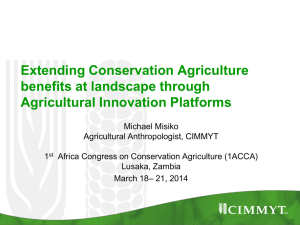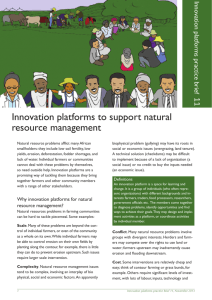Scaling up CA - 1st Africa Congress on Conservation Agriculture
advertisement
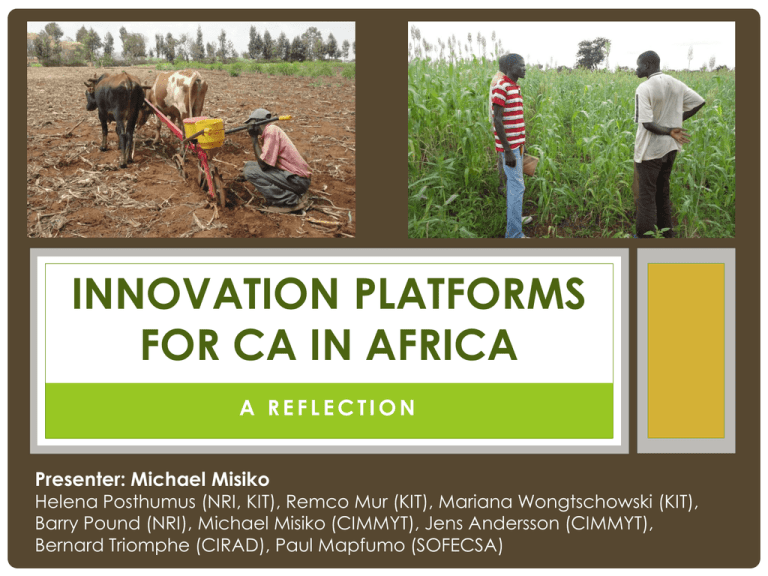
INNOVATION PLATFORMS FOR CA IN AFRICA A REFLECTION Presenter: Michael Misiko Helena Posthumus (NRI, KIT), Remco Mur (KIT), Mariana Wongtschowski (KIT), Barry Pound (NRI), Michael Misiko (CIMMYT), Jens Andersson (CIMMYT), Bernard Triomphe (CIRAD), Paul Mapfumo (SOFECSA) INTRODUCTION • Conservation Agriculture: • Sustainable agricultural intensification • Increase farmers’ resilience to climatic variability • Address soil degradation • BUT agro-ecological and socioeconomic factors limit adoption • CA requires: • Technological & institutional changes in agricultural systems • Strong capacity for problem solving from farmers and service providers to adapt CA to local circumstances CONSTRAINTS TO SCALING OUT CA So what are the main issues? •Emphasis on CA as technology; but for farmers it is (one of many) means to an end for: • Sustainable livelihoods • Food security • Risk reduction / resilience •CA is complex – requires change at multiple levels •System thinking is necessary. Not only farming system, but also economic (value chains) and institutional systems at local, district and national level! INNOVATION > RESEARCH + EXTENSION Agricultural innovation = process whereby individuals and organisations bring existing or new products, processes and form of organisation into social and economic use (FAO, 2014) Innovation is a combination of changes in: •Technology (hardware) •Knowledge (software) •Organisation (orgware) INNOVATION MODELS 1960 1980 2000 Technology Transfer Research Research Extension NGOs Extension Farmers Farmers Private sector: Innovation System Agro-dealers, Service providers, Traders INNOVATION MODELS Technology transfer Innovation system • Single techniques: • System change: • Improved crop variety • Fertilizers • Improved tools • Research is driver of innovation • Extension is driver of dissemination / outscaling Research Extension Farmers • Institutional change • Access to markets / value chains • Multi-stakeholder processes • Participatory research • Innovation driven by multiple actors in system Problem: CA cannot be packaged into simple rules for dissemination through technology transfer Current R&D system (research institutes, service providers, ministries) is divided by technical areas and operate based on technology transfer principles System change is required! Research, extension, NGOs Farmers Private sector: Agro-dealers, Service providers, traders INNOVATION PLATFORMS Current challenges in context of CA: •Driven by researchers, not farmers or private sector •Limited participation of private sector •Focus on predetermined solution (CA) rather than understanding the challenges •Limited co-innovation between farmers, researchers, extension, private sector INNOVATION PLATFORMS Role of innovation platforms: •Innovation platforms address shared constraints in system (e.g. value chain) •If focus is on technology instead, innovation platforms often used for dissemination, not institutional change •Innovation platforms at different levels have different roles: • Local: experimentation, adaptation of solutions to local context • District: multi-stakeholder process to achieve system change to address constraints in agricultural system • National: task force for advocacy or policy change INNOVATION PLATFORMS Role of innovation platforms: •Innovation platforms should: • Experiment with potential solutions to address farmers’ problems • Facilitate access to, and development of, variety of technologies from which farmers can chose • Create enabling environment for sustainable agricultural intensification • Facilitate connections of different actors at all levels so collaboration becomes more natural • Improve access to services, credit, transport, markets, knowledge, technologies, seeds, agricultural inputs • Identify strategies that link income generation to land rehabilitation BEST PRACTICES Best practices of innovation platforms for CA: •Village committees in Burkina Faso: platforms to discuss use and management of natural resources •Learning Centres Zimbabwe?? PAUL MAPFUMO?? WAY FORWARD? • Dynamic interaction between research, farmers and other stakeholders at multiple levels (joint experimentation, feedback loops, etc) • Need to address economic & institutional constraints to create enabling environment for agricultural innovation • • • • • • Markets / value chains (tension commodities vs farming systems) Access to agricultural inputs, seed policies Create better access to knowledge and technologies for farmers Integration of policies and actors at multiple levels Facilitate interaction, critical reflection & learning, between actors Capacity building for institutional development, facilitation of innovation processes • Engagement of farmers as equal partners in all activities! THANK YOU




